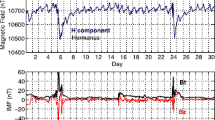Abstract
The processes of the sudden energy release and energy transfer, and particle accelerations are the most challenge fundamental problems in solar physics as well as in astrophysics. Nowadays, there has been no direct measurement of the plasma parameters and magnetic fields at the coronal energy release site. Under the certain hypothesis of radiation mechanism and transmission process, radio measurement is almost the only method to diagnose coronal magnetic field. The broadband dynamic solar radio spectrometer that has been finished recently in China has higher time and frequency resolutions. Thus it plays an important role during the research of the 23rd solar cycle in China. Sometimes when there were very large bursts, the spectrometer will be overflowed. It needs to take some special process to discriminate the instrument and interference effects from solar burst signals. According to the characteristic of the solar radio broadband dynamic spectrometer, we developed a nonlinear calibration method to deal with the overflow of instrument, and introduced channel-modification method to deal with images. Finally the interference is eliminated with the help of the wavelet method. Here we take the analysis of the well-known solar-terrestrial event on July 14th, 2000 as the example. It shows the feasibility and validity of the method mentioned above. These methods can also be applied to other issues.
Similar content being viewed by others
References
Fu, Q., Qin, Z., Ji, H. et al., A Broadband spectrometer for decimeter and microwave radio bursts, Solar Physics, 1995, 160: 97–103.
Ji, H., Fu, Q., Liu, Y. et al., 2.6 — 3.8 GHz solar radio dynamic spectrometer, Acta Astrophys. Sinica (in Chinese), 2000, 20(2): 209–215
Yan, Y., Huang, G., Recent progress on Chinese solar radio broadband fast dynamic spectrometers, Progress in Astronomy (in Chinese), 2001, 19(2): 134–138.
Wang, S., Yan, Y., Fu, Q., Extended radio emission after the soft X-ray Maximum of the NOAA 9077 AR solar flare on July 10, 2000, A&Ap Letters, 2001, 370: L13-L16.
Wang, S., Yan, Y., Zhao, R. et al., Broadband radio bursts and fine structures during the great solar event on 14 July 2000, Solar Physics, 2001, 204: 153–164.
Karlicky, M., Yan, Y., Fu, Q. et al., Drifting radio bursts and fine structures in the 0.8 — 7.6 GHz frequency range observed in the NOAA 9077 AR (July 10 — 14, 2000) solar flares, A&Ap, 2001, 369: 1104–1111.
Yan, Y., Deng, Y., Karlicky, M. et al., The magnetic rope structure and associated energetic processes in the 2000 July 14 solar flare, Ap. J. Letters, 2001, 551: L115-L119.
Tanaka, H., Castelli, J. P., Covington, A. E. et al., Absolute calibration of solar radio flux density in the microwave region, Solar Physics, 1973, 29: 243–262.
Rohlfs, K., Wilson, T. L., Tools of Radio Astronomy, Berlin: Springer-Verlag, 2000.
Zhao, R., Jin, S., Fu, Q., Solar Radio Bursts in Microwave (in Chinese), Beijing: Science Press, 1997.
Author information
Authors and Affiliations
Corresponding author
Rights and permissions
About this article
Cite this article
Yan, Y., Tan, C., Xu, L. et al. Nonlinear calibration and data processing of the solar radio burst. Sci. China Ser. A-Math. 45 (Suppl 1), 89–96 (2002). https://doi.org/10.1007/BF02889689
Received:
Issue Date:
DOI: https://doi.org/10.1007/BF02889689




